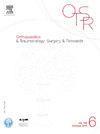肌肉成分不是前交叉韧带手术后肌肉力量恢复的预后因素。
IF 2.2
3区 医学
Q2 ORTHOPEDICS
引用次数: 0
摘要
目的:对于运动员来说,前交叉韧带(ACL)断裂及其手术治疗往往是他们职业生涯的转折点。成功和恢复运动的时间是运动员及其支持人员的基本参数,因此了解影响前交叉韧带重建(ACLR)后恢复运动的预后因素至关重要。本研究的目的是确定腘绳肌组成对自体腘绳肌移植ACLR术后肌肉力量的影响。方法:24例慢性前交叉韧带撕裂患者在单中心随访17个月。他们接受了手术修复,在此过程中,从股薄肌和半腱肌中收获移植物。通过免疫染色对通常被丢弃的半腱肌的剩余近端部分进行肌肉成分评估。根据门诊康复6个月后的标准化方案,在6个月时通过等速测力仪比较手术腿和健康腿的力量来确定肌肉力量。还研究了其他各种内在和外在因素,如体重指数(BMI)、年龄、性别、吸烟或运动,以确定影响ACLR后等速力量测试的因素。结果:手术腿与正常腿的肌肉组成与肌力之间无统计学关系。吸烟和女性与较差的肌肉恢复有关。6个月时,年龄和BMI对等速运动表现没有影响。结论:ACLR术后6个月时两腿力量差异与肌肉组成无关。确定患者的肌纤维组成不能告知康复方案或预测肌力恢复。要了解性别或烟草对肌纤维特性的影响,需要更大的系列数据。证据等级:一级;前瞻性预后研究。本文章由计算机程序翻译,如有差异,请以英文原文为准。
Muscle composition is not a prognostic factor for muscle strength recovery after anterior cruciate ligament surgery by hamstring tendon autograft
Purpose
For the athlete, anterior Cruciate Ligament (ACL) rupture and its surgical management are often a turning point in their career. Success and time to return to sport are essential parameters for athletes and their support staff, so it is critical to understand the prognostic factors influencing return to sport after anterior cruciate ligament reconstruction (ACLR). The aim of this study was to determine the influence of hamstring muscle composition on muscle power following ACLR with autogenous hamstring grafts.
Methods
24 patients with chronic torn ACL were included at a single-center over a period of 17 months. They underwent surgical repair and during this procedure grafts were harvested from the gracilis and the semitendinosus. Muscle composition was assessed on the remaining proximal part of the semitendinosus muscle, which is usually discarded, by immunostaining. Muscle power was defined by comparing the strength of the operated leg and the healthy leg on an isokinetic dynamometer at 6 months according a standardized protocol after 6 months of outpatient rehabilitation. Various other intrinsic and extrinsic factors were also studied, such as body mass index (BMI), age, sex, smoking, or sport practiced, to determine factors influencing isokinetic strength test after ACLR.
Results
No statistical relationship was identified between muscle composition and the muscle power between the operated and healthy leg. Smoking and female gender were associated with worse muscle recovery. Age and BMI had no influence on isokinetic performance at 6 months.
Conclusion
Following ACLR muscle composition is not associated with difference in strength between the two legs at 6 months. Determining muscle fiber composition of the patient does not inform the rehabilitation protocol or predict muscle strength recovery. Larger series data is required to understand the influence of gender or tobacco on muscle fiber characteristic.
Level of Evidence
: I; Prospective prognostic study.
求助全文
通过发布文献求助,成功后即可免费获取论文全文。
去求助
来源期刊
CiteScore
5.10
自引率
26.10%
发文量
329
审稿时长
12.5 weeks
期刊介绍:
Orthopaedics & Traumatology: Surgery & Research (OTSR) publishes original scientific work in English related to all domains of orthopaedics. Original articles, Reviews, Technical notes and Concise follow-up of a former OTSR study are published in English in electronic form only and indexed in the main international databases.

 求助内容:
求助内容: 应助结果提醒方式:
应助结果提醒方式:


